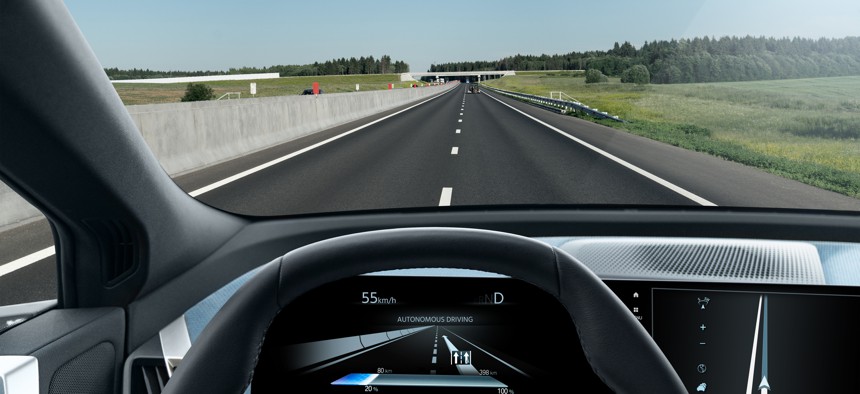In northern Minnesota, autonomous vehicles are hitting rural roads

Scharfsinn86/Getty Images
As Grand Rapids becomes the first rural community in the nation to pilot an autonomous shuttle service, it’s a trial by snow and ice rather than fire.
On a damp evening in Grand Rapids, Minnesota, just after a rainstorm, a white van drove up through an empty high school and performing arts center parking lot.
The van that picked me up, a Toyota Sienna, looks different from a regular Sienna. It has a cylinder mounted just above the windshield. Someone is in the drivers’ seat, but they aren’t actually driving. Instead, they are outfitted with a headset, ready to take over in case something goes wrong. To their left, a mobile device shows where the vehicle is going. It also plays the baseball charge tune every time the vehicle goes through an intersection. (Ann Arbor-based May Mobility, the company that operates the van, says this feature “denote[s] certain functionality during rides and represents a little bit of irreverence from our engineers.”)
The vehicle is one of five that comprises something unprecedented: it is part of the first autonomous shuttle service to operate in a rural community in the United States. These vans took to the road in September, and for the following 18 months they will navigate around Grand Rapids, located in northern Minnesota, in conditions unfamiliar to them: snow, extreme cold, and lots and lots of trees. If it works out, it could prove to be a solution to help those with limited mobility who live in remote, rural areas get around. It could also affect the workforce for good, and for bad.
How it all began
The journey to the first autonomous vehicles running in a rural community began with achieving a Guinness World Record.
Myrna Peterson, a retired teacher who uses a wheelchair because of a 2004 accident, wanted to get a convoy of 300 people rolling in their wheelchairs in a line for three minutes. She got 350.
She was surprised by how many people she saw come out because she had never seen them before. “We had four community meetings to say, ‘Why don't we see you?’ Number one was they can't get there. No transportation,” said Peterson.
Today, more people with limited mobility are living in rural America. For rural counties across the United States with no concentrated core population of 10,000 people or greater, 18% lived with a disability in 2019, up from 17.71% in 2014. In Itasca County, which contains Grand Rapids, 17% of residents lived with a disability in 2020, up from 15% in 2012.
And the rural geriatric population is growing, too. According to the Census, those 65 and over comprised 17.5% of the rural population in 2016 compared to 15.7% in 2010. In Itasca County, 23.4% of residents were 65 and over in 2020, compared to 19.1% in 2012.
Meanwhile, communities struggle to keep up with building and maintaining the infrastructure they need to get around. Rural communities, such as Grand Rapids, often lack sidewalks on many streets, and while they want to build them out, not all of their streets are wide enough to handle them. They also face a shortage of concrete.
Even where sidewalks do exist, rural communities have limited resources to keep them clear during the winter, especially after a snowfall. “Even if the sidewalks are plowed, the big trucks go by and plug in the cutaways, so I can't get off [the sidewalk],” said Peterson. “So I go on the side of the road against traffic. I'm stuck going close to the highway. And that's scary for people and for me.”
This is why Peterson founded Mobility Mania, which partnered with the Minnesota Department of Transportation, the city of Grand Rapids, May Mobility, New York City-based transportation technology company Via, and a St. Paul, Minnesota-based consulting firm called The PLUM Catalyst, to deploy the project. Called goMARTI, where the MARTI stands for Minnesota’s Autonomous Rural Transit Initiative, the project cost $3.5 million to deploy, with a share of this funding coming from the state.
Welcome to your first Minnesota winter, autonomous vehicle
Even though the community has two transportation options — it’s served seven days a week by a taxi company and Arrowhead Transit, Minnesota’s largest transit agency by area — Mobility Mania hopes the autonomous shuttle program can keep people with limited mobility connected to their communities, particularly on evenings and weekends.
“What we're hoping for is increase[d] independence, decrease[d] isolation, and [to] just promote mental health for people feeling a part of their community, and being able to get to their family,” says social worker Lisa Arnold. “People just didn't have an option, so now we have an option. And we're so proud to be [a part] of that project.”
But unlike the two preceding services, which make door-to-door stops in and around Grand Rapids and require calling ahead, the autonomous vehicles stop at one of 70 places, designated by a sign mounted on a pole, that one must walk or roll to. Matt Wegwerth, Grand Rapids Public Works Director, said their department looked into a number of factors when placing stops.
“We looked at our commercial district, which is on the south end of town,” said Wegwerth. “We have our Target, our Super One Foods. We looked at our schools, and our high school and elementary schools, and then kind of the housing … where are the areas that people will most likely need to use it? Multifamily areas, those kind of parts of town?”
The autonomous vehicles, which can be dispatched by an app in minutes or by calling 211, are also free to ride, compared to the other services, which cost $2 and up. The shuttle operates Tuesday through Friday during the afternoons into the late evening, as well as most of Saturday. On Sundays, they operate the same hours as Arrowhead Transit: 8:00am to 2:00pm.
I rode the service five times during a visit in early October to see about speaking with other riders, as well as to see more of the town I had only visited once previously. Although no other riders joined, the Minnesota Department of Transportation did report 29 rides, half of which required a wheelchair-accessible vehicle, a day after goMARTI launched. And the AV attendants reported seeing more people than they have ever seen onboard their vehicles in their first week.
Deploying a shuttle in a rural environment, which would allow people of all ages and abilities to get around without having to navigate an icy and snowy sidewalk (if one exists), presents a number of challenges. Like humans on a hike through a dense forest, autonomous vehicles can easily get lost where surroundings look similar. This can get worse in the winter, as snow changes the landscape.
Wary of how autonomous vehicles might perform, Minnesota Senator Jim Abeler of Anoka, a community located 20 miles northwest of Minneapolis, introduced a bill to ban them from Minnesota roadways in 2021. The bill did not receive a hearing.
Those developing autonomous vehicles may have a solution for these challenges though. The project team partnered with Grand Rapids High School students taking an engineering design class to design and build 10 transportation-themed pylons, which are much more elaborate than pylons found at, say, a hiking trail intersection.
“These added fixtures have been placed along the roadway, aiding in the localization process by creating a structure near the vehicle in rural stretches” one they can recognize, says MnDOT spokesperson Julie Bartkey.
Zach Pero, a sophomore at Grand Rapids high school who took the class, enjoyed designing the pylons. “It was really fun for me, and I liked just creating stuff on the computer,” says Pero, who made a first responder-themed pylon.
Workforce challenges
Deploying autonomous vehicles threatens to upend workforce needs as we know them. One obvious change is that transportation companies might not need to worry about recruiting drivers anymore.
This, of course, concerns those who drive to make a living. Take Rapids Taxi, the Grand Rapids-based taxi company. Its owners had no idea the project was happening until the shuttles began to hit the road in late September.
Short-term, they are worried about unfair competition that threatens to put them out of business and their workers out of work. “It would be really hard for us to compete with this because all of their rides are free. Because it's being funded through grants or government, but you know, we obviously have to charge our customers, so right there we have a very uncompetitive edge,” says Rapids Taxi co-owner Debi Byers. “We're working our butts off here to keep this town rolling, and it just seems like they came in out of nowhere.”
Long-term, they also believe the human element is important. Tom Whiteside, a union organizer for AFSCME Council 65 who represents Arrowhead Transit drivers, agrees because of how drivers can help those with limited mobility board and deboard, particularly during the winter.
“There is a population of riders with significant mental and physical handicaps and our drivers help them enter and exit the vehicles, says Whiteside. “This can be especially important in rural Minnesota where there are significant snowfall events in the winter and sidewalks and other pickup spots may be slippery and covered in snow.”
He also believes drivers need training to get into other industries if they end up being eliminated. “If this sort of technology does displace any workers, [then there should be] training available to our members, to retrain them in fields that can either service these autonomous vehicles or get training in another field where they can continue their employment,” says Whiteside.
That’s exactly what the Minnesota Governor’s Connected and Automated Vehicles advisory council, which has met for three years, is working on now. However, they have not yet put forth any solutions, and the group has no members who represent unionized transportation workers.
But with Arrowhead Transit being plagued by a shortage of drivers which required them to cut service elsewhere in their service area, perhaps autonomous vehicles, if proven, could solve their workforce woes.
For now, the goMARTI operation is staffed by a number of full and part-time workers, some of whom have backgrounds in computer science. Although they are employed through a New York-based staffing agency, they all live within 40 miles of Grand Rapids. They make $18 an hour plus benefits.
It’s not just driver shortages, however. Decades of pushing people towards four-year degrees and undervaluing shorter programs and other certifications has resulted in a shortage of workers in the skilled trades — people who will be needed to design and maintain autonomous vehicles and their infrastructure. Although the class that developed the pylons taught by Matt Sandys is focused on engineering, at the end of the day, anyone interested in problem solving can take it.
“We try to incorporate draftsman skills, also with our engineering design process that most colleges and engineers use,” says Sandys. “[But] we literally just try to find the best fit for that student to make them successful in life.”
More Autonomous Vehicles in Rural Places?
There may be more autonomous vehicle systems — and more workforce changes and development opportunities — to come for rural communities. The Bipartisan Infrastructure Law passed last year includes $500 million over the next five years for public agencies to develop autonomous vehicle systems. Pending rulemaking as of this writing, applicants might not need to comply with Buy America provisions, potentially allowing them to work with providers overseas to deploy projects across the nation.
Despite other transportation options existing in the community, Peterson prefers having access to an autonomous vehicle. use I take my own wheelchair around, and I have an accessible van. But I'm on somebody else's time, I lose my independence,” says Peterson. use I have goMARTI … I'm independently going and doing what I want, where I want.”
This article first appeared on The Daily Yonder and is republished here under a Creative Commons license.![]()





